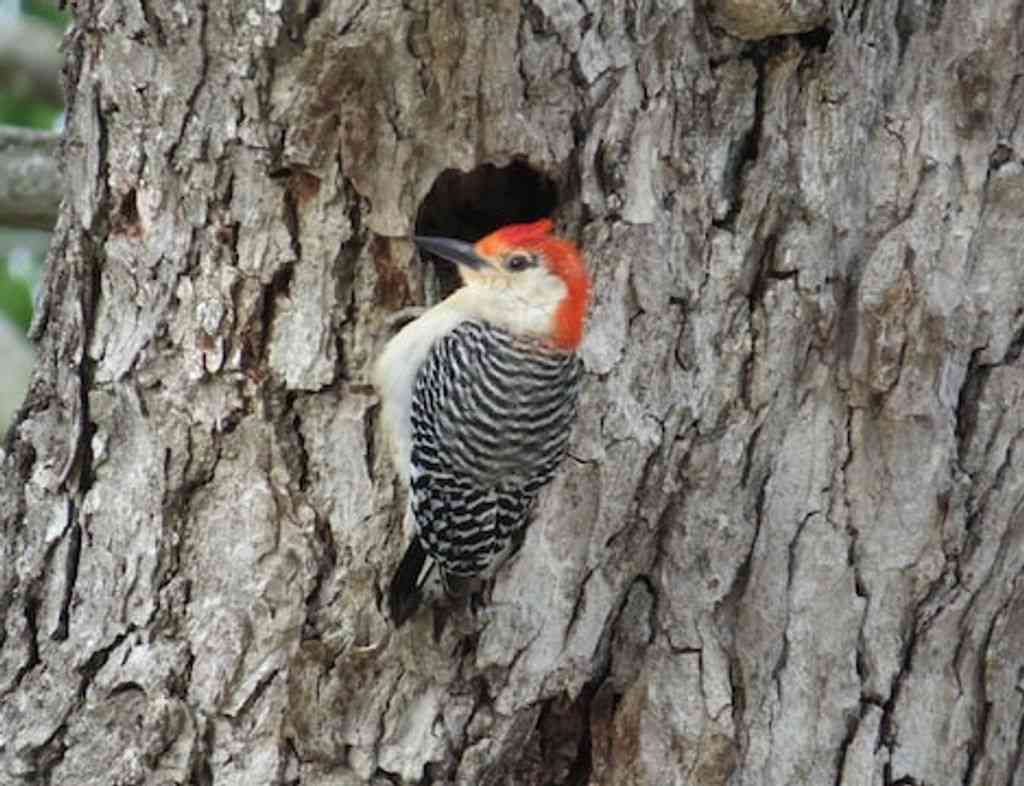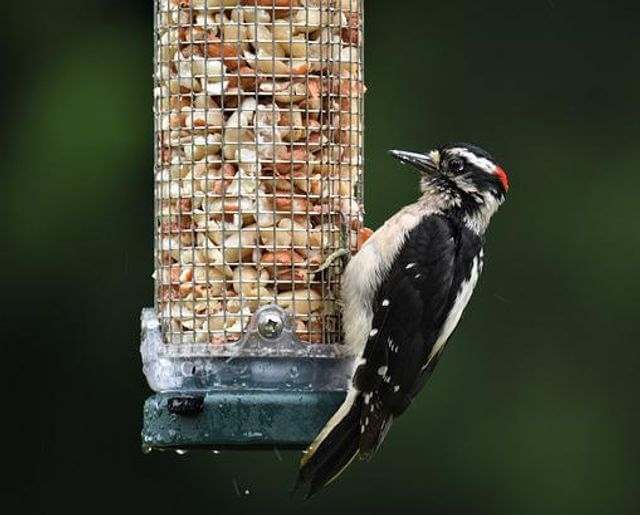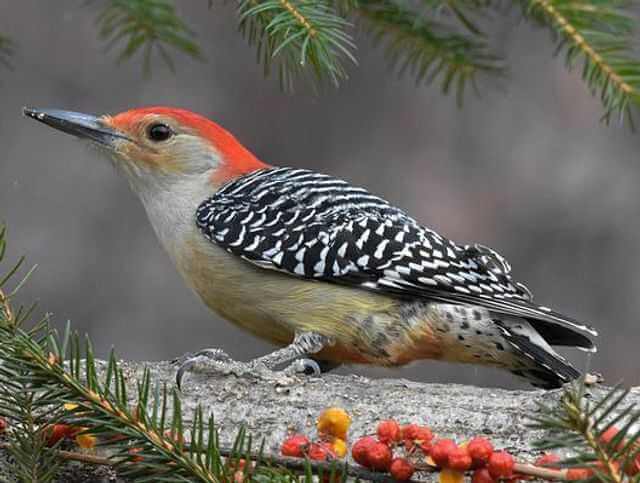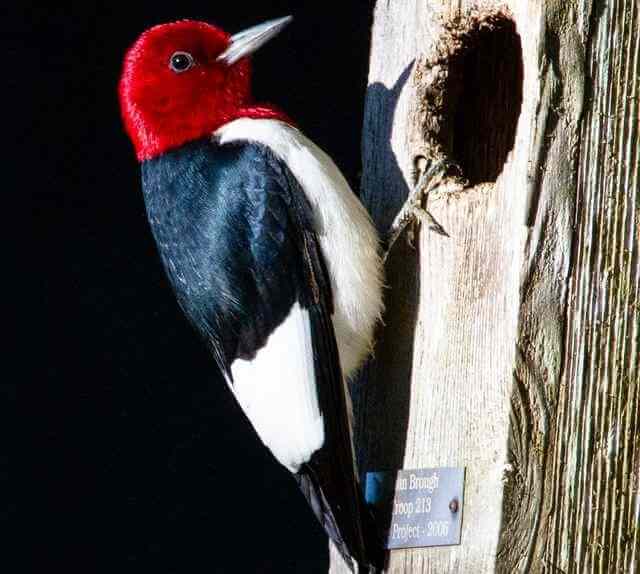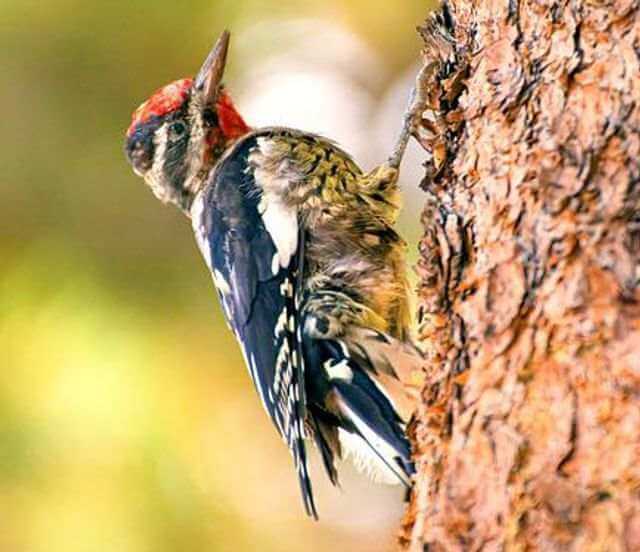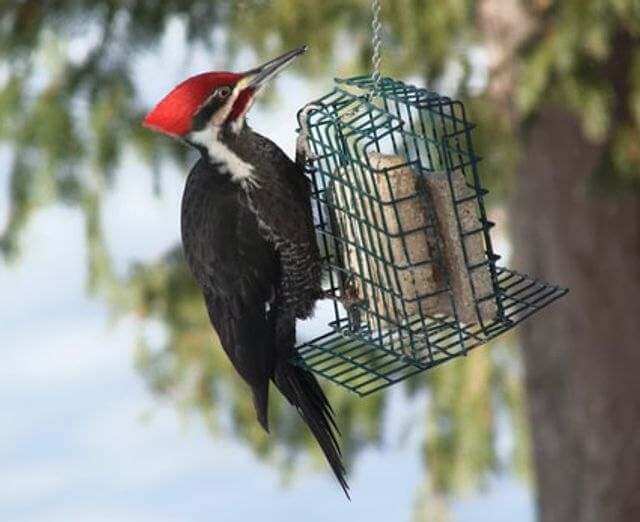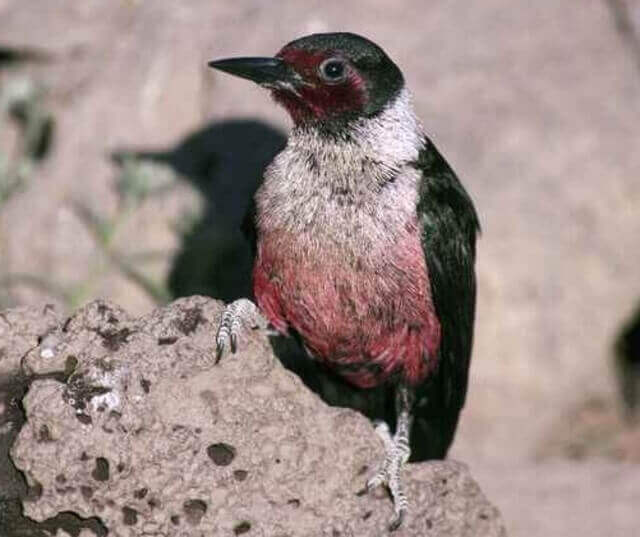Hey fellow nature enthusiasts! Ever marveled at the sight of a woodpecker? Well, here in Illinois, we’ve got quite the woodpecker squad – eight amazing species! Join me on a journey as we explore Illinois’ woodlands and meet these fascinating birds.
From their vibrant colors to their rhythmic drumming, each woodpecker has its own story. In this article, we’ll discover all 11 species that call Illinois home, with stunning photos and handy tips to help you spot them in the wild. So grab your binoculars and let’s dive into the world of woodpeckers together!
Table of Contents
Types of Woodpeckers in Illinois
Downy Woodpecker
- Length: 5.5-6.7 in (14-17 cm)
- Weight: 0.7-1.0 oz. (21-28 g)
- Wingspan: 9.8-11.8 in (25-30 cm)
- Scientific Name: Picoides pubescens
- Frequency of Occurrence: 33.73% (Statistic by: eBird)
- Where To Find Them: The Downy Woodpecker is a common bird in Illinois. They can be found in many locations, but some of the best spots are the Low Preserve near Geneva, the Shawnee Forest Preserve near Pana, and the Sauk Prairie Wildlife Management Area.
- How to Attract: One of the best ways to attract them is by providing them with food and water. You can also try setting up some bird feeders with black oil sunflower seeds, millet, peanuts in your yard or planting some trees that they may eat from. In addition, making sure that your yard is clean and free of debris will also help make them feel at home.
Description: The Downy Woodpecker is a common bird found throughout much of North America. The distribution range extends from the eastern seaboard to the western border of Canada, and from the Great Lakes region to the Gulf of Mexico. This woodpecker prefers areas with dense growth, such as trees and shrubs in moist woodlands or along streams.
They also build nests in cavities in tall trees or poles. Their diet consists largely of insects, such as ants, beetles, and caterpillars, but they will also eat seeds and berries if available.
Related Post: How to Attract Downy Woodpeckers to Your Yard? (Easy!)
Red-bellied Woodpecker
- Length: 9.5 in (24 cm)
- Weight: 2.0-3.2 oz. (56-90 g)
- Wingspan: 13.0-16.5 in (33-42 cm)
- Scientific Name: Melanerpes carolinus
- Frequency of Occurrence: 28.31%
- Where To Find Them: The red-bellied woodpecker can also be found near the cities of Chicago, Carbondale, and Champaign.
- How to Attract: You can attract them by providing them with plenty of food options such as peanuts, suet or sunflower seeds. You can also try to set up a nestbox near your property so they can stay nearby.
Description: The red-bellied woodpecker is a common bird in most of the eastern United States. It ranges from Nova Scotia to central Texas, and south to Florida and Louisiana. The woodpecker is found in deciduous and mixed forests, as well as in orchards and gardens. It scavenges for food, especially insects, but also small mammals, birds eggs, nuts, seeds, berries and fruit.
The red-bellied woodpecker nests in large cavities in trees. The male excavates a hole in the tree trunk or side with his bill. The female typically lays two to six eggs per clutch, and both parents incubate them. Young woodpeckers leave the nest after about four weeks.
Related Post: How to Attract Red-bellied Woodpeckers to your Yard?
Northern Flicker
- Length: 11.0-12.0 in (28-31 cm)
- Weight: 3.9-5.6 oz. (110-160 g)
- Wingspan: 16.5-20.0 in (42-51 cm)
- Scientific Name: Colaptes auratus
- Frequency of Occurrence: 18.30%
- Where To Find Them: Some common locations in Illinois where the Northern Flicker can be found are in the Chicago metropolitan area, the Quad Cities, and along the Mississippi River.
- How To Attract: To attract them to your yard, provide a healthy food source such as peanut hearts or sunflower seeds that they can eat, and make sure the environment is inviting. Make sure to keep your garden clean and free of debris, and add a nestbox if you can.
Description: The Northern flicker is the most common woodpecker in North America. They have a distribution range that extends from the eastern seaboard to western Oregon and California. The flicker prefers deciduous and mixed forest but can be found in other habitats such as coniferous forests, riparian areas, and suburban gardens. This bird mostly consumes insects, spiders, arthropods, nuts, seeds, berries and some fruit.
The Northern flicker is a cavity nester and constructs its nests out of wood chips. Nests can be solitary or in colonies of up to 12 pairs. They are socially monogamous and usually breed once per year, laying 5-8 eggs per clutch. The young are fed by their parents for about 6 weeks after fledging.
Related Post: How to Attract Northern Flickers to your Backyard (Easy)
Hairy Woodpecker
- Length: 7.1-10.2 in (18-26 cm)
- Weight: 1.4-3.4 oz. (40-95 g)
- Wingspan: 13.0-16.1 in (33-41 cm)
- Scientific Name: Picoides villosus
- Frequency of Occurrence: 9.92%
- Where To Find Them: They are most commonly found in the northcentral and northern parts of the state, although they have been spotted as far south as Carbondale.
- How To Attract: To attract them to your yard, try providing food sources such as fruit or bird seed in areas where they commonly forage. You can also hang feeders high up in trees or poles, or put out a variety of bird houses and nesting materials. If you have a garden, make sure to include plants that hairy woodpeckers like to feed on, like apple trees or sumac bushes.
Description: The Hairy Woodpecker is a medium-sized woodpecker found in North America. The bird ranges from eastern Canada south to central Mexico, and west to southeastern Arizona and New Mexico. It also occurs on the Pacific coast of South America. The Hairy Woodpecker is closely related to the Downy Woodpecker and is sometimes classified with it.
The Hairy Woodpecker’s natural habitat are mixed deciduous and coniferous forests, but the bird can also be found in urban areas. The bird feeds mainly on insects, such as beetlelarvae, moths, ants, bees, wasps, caterpillars, spiders, millipedes, but will also eat fruits and seeds. It builds its own nest lined with wood chips in a tree cavity or on a utility pole.
Red-headed Woodpecker
- Length: 7.5-9.1 in (19-23 cm)
- Weight: 2.0-3.2 oz. (56-91 g)
- Wingspan: 16.5 in (42 cm)
- Scientific Name: Melanerpes erythrocephalus
- Frequency of Occurrence: 5.48%
- Where To Find Them: The Red-headed Woodpecker is a common bird found throughout Illinois. They can be found in many locations, including the suburbs of Chicago and Springfield.
- How to Attract: Make sure there are plenty of fruit trees and nuts in your area – these birds love to eat! Try planting some deciduous trees near your home – these provide shelter from the sun and can provide plenty of food for the woodpeckers. Keep your yard clean and well groomed – this will give the birds a healthy place to live and play. Install a birdfeeder made out of plastic or metal, and filled with peanuts, or black-oil sunflower seeds, this will give the woodpeckers something to peck at while they’re waiting for their next meal.
Description: The Red-headed Woodpecker is a common bird in the eastern United States. It is found in most of the Appalachian Mountains from Georgia to Maine, as well as in parts of the Midwest and Northeast. The woodpecker prefers to live in areas with dense tree cover, but it can also be found near open woodland and meadows. As its name suggests, the redhead’s head is bright red.
This coloration helps to camouflage the bird when it is foraging for food among the branches of trees. The Red-headed Woodpecker’s diet consists mostly of insects, but it will also eat fruit if available. It constructs its nests out of wood chips., usually in cavities that are high up in trees.
Related Post: Interesting Red-Headed Woodpecker Facts (Explained)
Yellow-bellied Sapsucker
- Length: 7.1-8.7 in (18-22 cm)
- Weight: 1.5-1.9 oz. (43-55 g)
- Wingspan: 13.4-15.8 in (34-40 cm)
- Scientific Name: Sphyrapicus varius
- Frequency of Occurrence: 2.87%
- Where To Find Them: They can be found in many different locations, but some of the most popular spots are around Lake Michigan and near Chicago.
- How to Attract: Install a platform feeder with mealworms in your yard, and make sure it has plenty of fresh food available for the birds. Another thing you can do is plant bug-eating plants in your yard, such as blueberry bushes or sumac trees, which will provide food for the birds.
Description: The Yellow-bellied Sapsucker is a species of bird in the woodpecker familyPicidae. It is found in eastern North America. The Yellow-bellied Sapsucker is a migratory bird that spends winters in Central and South America. The distribution range extends from Nova Scotia to southern Texas and west to eastern Colorado, Kansas and Oklahoma.
The habitat consists of open deciduous forests, coniferous forests, riparian areas, gardens, orchards, and urban areas. The diet consists mainly of arthropods, but also includes tree sap, fruits, and nuts. The birds build their nests in cavities in trees or poles.
Related Post: 16 Interesting Sapsucker Facts Revealed!
Pileated Woodpecker
- Length: 15.8-19.3 in (40-49 cm)
- Weight: 8.8-12.3 oz. (250-350 g)
- Wingspan: 26.0-29.5 in (66-75 cm)
- Scientific Name: Dryocopus pileatus
- Frequency of Occurrence: 2.59%
- Where To Find Them: Pileated Woodpeckers can be found in a variety of locations throughout Illinois, including the Chicago metropolitan area. They are most commonly spotted in the northern part of the state, but have been seen as far south as Carbondale and as far west as Macomb County. The birds can also be found in smaller numbers around Rockford and Springfield.
- How To Attract: There are a few things you can do to help attract these birds to your backyard. One simple way is to provide them with plenty of fruit, and feeders with nuts and suet; they love these foods and will often visit your feeder multiple times per day. Another great way to attract them is by providing them with new habitat; if you can create some holes in trees or build new perches for them in your yard, they will likely frequent these areas more frequently.
Description: The Pileated Woodpecker is a large woodpecker that can be found in most parts of North America. In the East, it ranges as far west as Texas and Oklahoma. In the Midwest, it can be found in Wisconsin, Illinois, Indiana, and Ohio. In the South, it ranges from Florida to Louisiana. The Pileated Woodpecker is primarily found in areas with tall trees and plenty of dead wood to forage on.
It excavates its own cavities in tree trunks or other solid objects using its hammer-like bill. These birds are solitary birds and usually only stay together during winter when they congregate around roosting sites. They are omnivorous and will eat insects, such as carpenter ants, termites, beetle larvae, but also seeds, nuts, berries and some fruit.
Lewis’s Woodpecker
- Length: 10.2-11.0 in (26-28 cm)
- Weight: 3.1-4.9 oz. (88-138 g)
- Wingspan: 19.3-20.5 in (49-52 cm)
- Scientific Name: Melanerpes lewis
- Frequency of Occurrence: 0.0048%
- Where To Find Them: The Lewis’s Woodpecker is a large woodpecker that can be found in many locations in Illinois. These include the city of Chicago, Cook County (including the city of Chicago), Grundy County, Livingston County, Macoupin County, Will County, and Wayne County. There are also scattered populations in Kankakee, Kendall, Lake, McHenry and Kane Counties.
- How to Attract: If you’re looking to attract the Lewis’s Woodpecker, be sure to provide plenty of fruit trees and birdfeeders with black-oil sunflower seed. These birds are attracted to shiny objects, so adding some extra sparkle to your yard can help draw them in. You can also try installing a birdbath or even a perch for them on your porch railing.
Description: The Lewis’s Woodpecker is a medium-sized bird that lives in the United States and southern Canada. It is found in open woodlands and forests, where it forages for insects. The Lewis’s Woodpecker has a distribution range that extends from southern New Hampshire to eastern Texas, and from Nova Scotia to Manitoba.
It prefers wooded areas with plenty of trees and shrubs, but it can also be found in urban areas. The Lewis’s Woodpecker feeds on bugs, including beetles, ants, and flies.Lewis’s Woodpeckers often use excavated cavities in trees for nestlings to fledge from; they usually nest in dead or weak trees, lined with wood chips.
Red-cockaded Woodpecker
- Length: 7.9-9.1 in (20-23 cm)
- Weight: 1.5-1.8 oz. (42-52 g)
- Wingspan: 14.2 in (36 cm)
- Scientific Name: Picoides borealis
- Frequency of Occurrence: 0.0014%
- Where To Find Them: Some of the more common areas where they can be found are in the Chicago metropolitan area, as well as parts of the southern and eastern portions of the state. They have also been spotted in counties such as Cook and LaSalle.
- How to Attract: There are several ways to attract this bird to your yard. One way is to install a feeder filled with nuts, seeds, or fruit. Another way is to plant pine trees, because they are a favorite food sources for the birds.
Description: The Red-cockaded woodpecker is a common bird found in most parts of North America. It ranges from the East Coast to the West Coast and throughout much of Central America. The woodpecker’s habitat includes open woodland, riparian areas, deciduous and coniferous forests, and urban gardens.It eats insects, larvae, and other small creatures from the tree canopy.
The woodpecker is primarily a cavity nester, using both dead and live trees as nesting sites. It excavates a small hole in a tree trunk or large branch and lays two to four eggs. Both parents share incubation duties, but the young leave the nest after about three weeks.
Black-backed Woodpecker
- Length: 9.1 in (23 cm)
- Weight: 2.1-3.1 oz. (61-88 g)
- Wingspan: 15.8-16.5 in (40-42 cm)
- Scientific Name: Picoides arcticus
- Frequency of Occurrence: 0.0001%
- Where To Find Them: Some of the states that they can be found in include: Alexander, Brown, Carroll, Champaign, Christian, Clark, Clay, Clinton, Coles, Cook, Crawford, Dent, Effingham.
- How to Attract: Install a platform feeder with black-oil sunflower seeds, or mealworms. This will give the woodpeckers something to peck at and keep them busy, providing them with a safe place to perch. Place a variety of trees and shrubs around the feeder so that they have plenty of places to hide. Create an inviting nest box for these birds by painting it green or adding some branches and leaves. Plant some fruit trees near the nest box so that they have plenty of resources to forage.
Description: The Black-backed Woodpecker is a common bird species in North America. It has a distribution range that spans from the southern United States all the way to central Canada. They prefer areas with dense trees and can be found in a variety of habitats, including forests, woodlands, and wetlands.
This woodpecker is usually seen in pairs or small groups, but can also be found living alone. They mainly feed on insects, and other small prey obtained by probing around tree trunks with its long bill. It constructs its own cavities in trees using moss, lichens, and wood shavings.
Williamson’s Sapsucker
- Length: 7.9-10.2″ in (20-26 cm)
- Weight: 1.5-2.0 oz (43-56 g)
- Wingspan: 16.5-17.0″ in (42-43.2 cm)
- Scientific Name: Sphyrapicus thyroideus
- Frequency of Occurrence: 0.0001%
- Where To Find Them: These birds are typically found in the central and northern portions of the state, but have been spotted as far south as Alton and Carbondale. The best places to find Williamson’s Sapsuckers are in forested areas with plenty of tree cover.
- How to Attract: Look for areas where Williamson’s Sapsuckers frequent, such as dead trees or undergrowth near water sources. Get creative with your birdfeeders! Add different types of food, like sunflower seeds, nuts or berries, to increase the odds of attracting this species. Try setting up a birdhouse made from natural materials, like wood or straw, to give the birds a place to stay and eat.
Description: The Williamson’s Sapsucker is a small woodpecker that breeds in the eastern United States and parts of Canada. The distribution range extends from New Jersey in the east, to Nova Scotia and Newfoundland in the north, and south to northern Florida and Georgia. The habitat includes hardwood forests, mixed forests, and spruce-fir forests.
The Williamson’s Sapsucker feeds on insects found in trees, such as caterpillars, beetles, ants, spiders, and other arthropods. It usually forages high in the tree canopy, where it can see a long way down. The cavity nesting habits of this bird are unusual because two females will excavate a single hole close to each other in a dead tree trunk. Both birds will incubate the eggs and care for the young.
Related Post: What Are The Most Common Backyard Birds in Illinois

